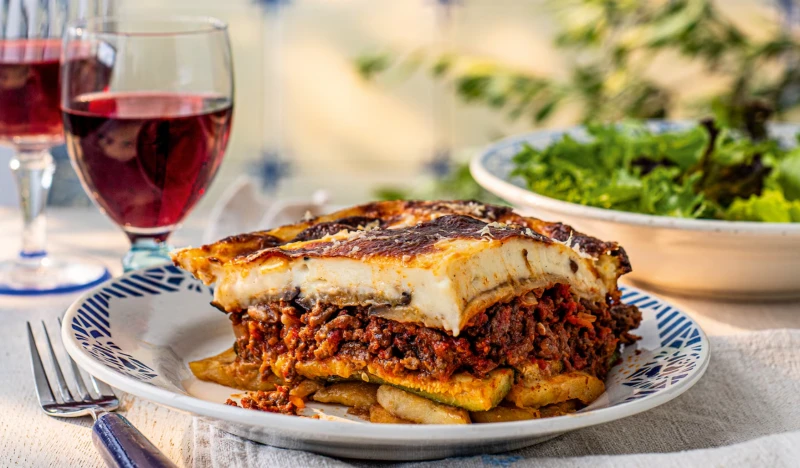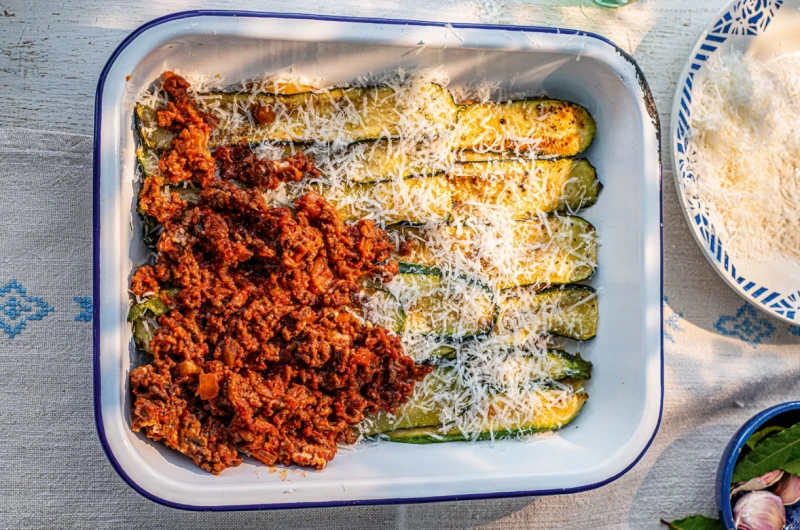Moussaka in Cyprus
This is a traditional Greek dish that has become one of the culinary symbols of Cyprus as well.
However, analogues of moussaka are found beyond Greece and Cyprus, and the word itself, although it came into English from Greek, was originally Arabic. But let's start from the beginning.
- What is moussaka
- Versions of moussaka
- History and name
- Greek moussaka
- Recipe of Greek moussaka
- Frequently asked questions about moussaka
 Ant Duncan / nationalgeographic.com
Ant Duncan / nationalgeographic.com
What is moussaka
Moussaka is a dish based on eggplants and/or potatoes, often with minced meat, widespread in the Balkans and the Middle East (in particular Cyprus), with many local and regional variations.
There are variations, sometimes without the top sauce, sometimes with other vegetables. Such versions may include, in addition to slices of eggplant, slices of salted zucchini, partially fried potato slices, or salted mushrooms.
However, just as much as the vegan stew of chickpeas and eggplants called moussaka or maghmour in Lebanon differs greatly from Albanian moussaka — pork with yogurt and potatoes — recipes vary widely and there is no single “correct” way to make moussaka, even within Greece itself.
The base of the dish generally remains unchanged: layers of eggplants and minced meat are topped with a creamy filling. However, finer details spark fierce debates.
Versions of moussaka
Versions in Egypt, Turkey, and the rest of the Middle East differ significantly. In Egypt, moussaka can be vegan or vegetarian, as well as with meat; in all cases, the main ingredient is fried eggplant. In Turkey, moussaka consists of thinly sliced and fried eggplants served in a meat sauce based on tomatoes, served warm or at room temperature. In Saudi Arabia, moussaka is eaten hot, while in other Arab countries it is more often eaten cold, but sometimes hot as well.
In Albania, Bulgaria, former Yugoslavia, and Romania, instead of eggplants and pork or beef mince, potatoes are used, and the top layer usually consists of milk or yogurt mixed with raw eggs, sometimes with the addition of a small amount of flour. There is also a three-layer variant: the bottom layer consists of pork and beef mince, the middle — of potato slices, and the top layer is usually custard. Each layer is prepared separately, then placed in a pan and baked until a golden crust forms.
History and name
The modern Greek version was created in the 1920s by Nikolaos Tselementes — a Greek culinary visionary of the early 20th century. But the history goes deeper.
The English name moussaka was borrowed from the Greek mousakás (μουσακάς) and other Balkan languages, which in turn borrowed it from Ottoman Turkish, which itself borrowed it from Arabic muṣaqqa’a (literally “crushed” or “cold,” but it also means “moistened”). The word first appears in English in 1862 spelled as mùzàkkà.
In Kitab al-Ṭabīkh, a 13th-century manuscript known in English as the “Baghdad Cookbook,” there is a recipe for “magmuma” or “mukatta’a,” consisting of alternating layers of eggplant and onion, meat with spices and fat, soaked in a sauce seasoned with vinegar.
Greek moussaka
The Greek version includes layers of meat and eggplants, topped with white sauce and baked.
The modern Greek version was created by the French-educated Greek chef Nikolaos Tselementes in the 1920s. His recipe has three layers, prepared separately and then combined for the final baking: the bottom layer of sliced eggplants fried in olive oil; the middle layer of lamb lightly fried with crushed or pureed tomatoes, onion, garlic, and spices (cinnamon, allspice, and black pepper); and the top layer of béchamel sauce or custard.
Moussaka Recipe
We present to you a recipe from Carolina Doriti — a Greek woman who has been working as a chef and restaurant consultant since 2005. Since 2013, she has been collaborating with Culinary Backstreets, a well-known American company specializing in culinary tours around the world.
This recipe serves 8–10 portions and takes about an hour and a half to prepare.
Ingredients for the meat sauce
- 2 tbsp olive oil
- 650 g ground beef (ideally from chop and shoulder cuts)
- 1 large onion, chopped
- 2 garlic cloves, minced
- 2 bay leaves
- 1 cinnamon stick
- 170 ml dry red wine
- 600 g tomatoes, peeled and blended, or canned crushed tomatoes (including the juice)
- 1 tsp tomato paste
- ½ tsp dried oregano
- 1½ tbsp chopped parsley
- a pinch of sugar (optional)
Ingredients for the vegetables
- 2–3 medium eggplants, sliced lengthwise into 1 cm thick slices
- olive oil for frying
- 3 potatoes, peeled and sliced into 1 cm thick slices
- 3 large zucchinis, sliced lengthwise into 1 cm thick slices
Ingredients for the béchamel sauce
- 1.5 liters whole milk
- 150 g butter
- 150 g all-purpose flour
- a pinch of freshly grated nutmeg
- 200 g kefalotyri or pecorino cheese, grated
Preparation
- To prepare the meat sauce, heat the olive oil in a large wide pan. Brown the ground beef, breaking it up as you stir, for 5–7 minutes. Add the onion, garlic, bay leaves, and cinnamon stick, and season with salt and pepper. Stir for a couple of minutes until the meat is nearly dry, then pour in the wine and stir again. Add the tomatoes and tomato paste and lower the heat; if the sauce seems too dry, add a bit of water.
- Let the sauce simmer gently, stirring occasionally, until most of the liquid is absorbed — about 30–40 minutes.
- Meanwhile, soak the eggplant slices in a bowl of warm salted water for 15–30 minutes, then pat them dry and set aside.
- Add oregano and parsley to the meat sauce. Adjust the seasoning and add sugar to taste, if desired, then stir again. Remove the cinnamon stick and bay leaves and discard them. Remove the pan from heat and set aside.
- Place another large pan over medium-high heat. Pour in enough olive oil to coat the bottom, then fry all the vegetables in batches, turning them until they are softened and golden on both sides (they don’t need to be fully cooked, as they will finish in the oven). Lay them on a tray lined with kitchen paper and season both sides with salt and pepper.
- Heat the milk for the béchamel in a saucepan. In another large saucepan over medium heat, gently melt the butter. Add the flour to the butter and whisk continuously. Gradually add the warm milk, whisking constantly, until all the milk is used and the sauce thickens (it should be of medium thickness — not too runny, and definitely not too thick). Add the nutmeg and remove from heat. Season with salt and pepper to taste.
- Add 5–6 tbsp of the béchamel sauce to the meat sauce and stir. Add 3 tbsp of grated cheese to the remaining béchamel sauce.
- Preheat the oven to 200°C (fan 180°C). Arrange the potato slices in a large deep baking dish. Layer the zucchinis on top and sprinkle with 2 tbsp of grated cheese. Pour the meat sauce over and smooth it out with the back of a spoon. Layer the eggplants on top, pour over the béchamel sauce and sprinkle with a little more grated cheese. Pour the remaining béchamel sauce and spread it evenly. Sprinkle with the remaining cheese and bake on the lower rack of the oven for 40–50 minutes or until golden. Remove from the oven and let cool for at least 20–30 minutes before serving.
 Ant Duncan / nationalgeographic.com
Ant Duncan / nationalgeographic.com
Frequently Asked Questions about Moussaka
Is there a vegan moussaka?
Nikolaos Tselementes proposed a vegan version for Orthodox fasting days. In Romania, there is also a vegan version where the meat is replaced with mushrooms or a mixture of sautéed onions and rice.
Where else is moussaka popular?
In the Balkans, Lebanon, Egypt, and Turkey, each place has its own regional variations.
What else to try in Cyprus?
Lots of options: shrimp saganaki, souvlaki, stifado, traditional meze and much more!
Follow our Instagram and Telegram — there we share a lot of useful and interesting information about traditional dishes in Cyprus!
